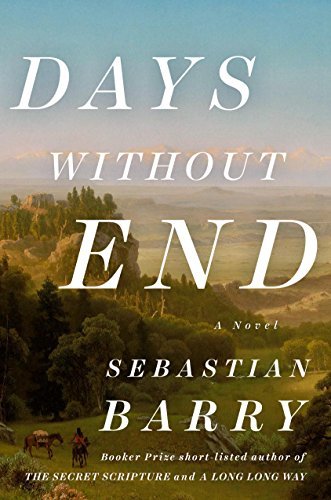Week 11 - Western Annotation
Geographical Setting: American West / Midwest
Time Period: 1850's
Series: Days Without End #1
Fleeing the Great Famine, Irish immigrant Thomas McNulty makes his way to America, where he meets John Cole; quickly forming a firm friendship as young men, they journey together, finding work, eventually joining the U.S. Army, and finding companionship between themselves as lovers.
As
soldiers, Thomas and John first find themselves mired within the brutal Indian
Wars of 1850’s America, then caught up in the carnage of the Civil War. However,
even experiencing the horrors of multiple wars, they make time for their personal
relationship and act as caretakers for a young Sioux girl, who they call Winona
and come to see as a daughter. Trying to not let the terrible wartime
experiences they have faced overwhelm and consume their lives, Thomas and John,
along with Winona, do their best to forge a life together as, for that time
period, an unconventional family.
Subject Headings:
Appeals:
At the end of Huckleberry Finn, on the eve of the Civil War, Huck and his pal Tom Sawyer “light out for the Territory” to avoid “sivilization.” In Robert Coover’s vision of their Western adventures, Huck and Tom start by joining the famous but short-lived Pony Express.
Tom becomes something of a hero and decides he’d rather own civilization than escape it, returning east to get a wife and a law degree. But Huck stays alone in the Territory; he guides wagon trains, scouts for both sides in the war, wrangles horses on a Chisholm Trail cattle drive, joins a bandit gang, finds an ill-fated pal in an army fort and another in a Lakota Sioux tribe, and eventually finds himself in the Black Hills just ahead of the 1876 Gold Rush. In the course of his adventures, Huck reunites with Tom, Jim, and Becky Thatcher and faces some hard truths and harder choices. --Goodreads
1866, Dakota Territory. Red Cloud’s coalition of tribes is
battling the U.S. Army to reclaim hunting grounds in the Powder River Valley.
Against this background, Wolves of Eden sets four men on a deadly
collision course in a narrative that explores the cruelty of warfare, the power
of love and the resilience of the human spirit. Lieutenant Martin Molloy and
his loyal orderly are sent west to investigate a triple murder at a frontier
fort, and Irish immigrant brothers Thomas and Michael O’Driscoll, who survived
the brutal frontlines of the Civil War, find themselves as both hunters and the
hunted in another bloody campaign. --Goodreads
Bobby Hale is a Union veteran several times over. After the war, he sets his sights on California, but only makes it to Montana. As he stumbles around the West, from the Wyoming Territory to the Black Hills of the Dakotas, he finds meaning in the people he meets-settlers and native people-and the violent history he both participates in and witnesses.
Far as the Eye Can See is the story of life in a place where every minute is an engagement in a kind of war of survival, and how two people-a white man and a mixed-race woman-in the midst of such majesty and violence can manage to find a pathway to their own humanity.
--Goodreads
Renowned storyteller Dee Brown, author of the
bestselling Bury My Heart at Wounded Knee, recreates the struggles
of Native Americans, settlers, and ranchers in this stunning volume that
illuminates the history of the old West that’s filled with maps and vintage
photographs.
Beginning with the demise of the Native Americans of the Plains, Brown depicts
the onrush of the burgeoning cattle trade and the waves of immigrants who
ultimately “settled” the land. In the retelling of this oft-told saga, Brown
has demonstrated once again his abilities as a master storyteller and an
entertaining popular historian.
By turns heroic, tragic, and even humorous, The American West brings
to life American tragedy and triumph in the years from 1840 to the turn of the
century, and a roster of characters both great and small: Red Cloud, Sitting
Bull, Geronimo, Dull Knife, Crazy Horse, Captain Jack, John H. Tunstall, Billy
the Kid, Pat Garrett, Wyatt Earp, the Hole-in-the-Wall Gang, Wild Bill Hickok,
Charles Goodnight, Oliver Loving, Buffalo Bill, and many others. --Amazon
This beautifully written trilogy of books on the American Civil War is not only a piece of first-rate history, but also a marvelous work of literature. Shelby Foote brings a skilled novelist's narrative power to this great epic. Many know Foote for his prominent role as a commentator on Ken Burns's PBS series about the Civil War. These three books, however, are his legacy.
His southern sympathies are apparent: the first volume opens by introducing Confederate President Jefferson Davis, rather than Abraham Lincoln. But they hardly get in the way of the great story Foote tells.
Native Americans make up less than one per cent of the total US population but represent half the nation's languages and cultures. Here, in one grand sweep, is the full story of Native American society, culture and religion. Here is everything from the land-based spirituality of their early creation myths and the late rise of Indian Pride, to the 88 uses to which the Sioux put the flesh and bones of the buffalo and the practice of berdache (men adopted as women).
The book offers a chronological history of America's
indigenous peoples. It covers their dramatic early entry into North America,
out of the now submerged continent of Beringia, then in more recent times the
'forgotten wars' of the 16th and 17th centuries, which wiped many tribes from
the face of the East Coast, and finally describes to the last struggles of the
Cheyenne and the Comanche. Celebrating these peoples' way of life rather than
focusing narrowly on the manner of their genocide, it does not ignore
uncomfortable facts of the Amerindian past - including the cannibalism believed
to have been practised by some tribes and the Native Americans' part in the
decimation of North America's buffalo herds. --Goodreads









The summary and appeals make this book sound fantastic! Great job writing those. The readalikes also look fantastic. I've never heard of this title before by it's on my tbr now!
ReplyDeleteMaryanne,
ReplyDeleteI appreciate seeing an annotation for westerns, particularly with the recommendations you give. This is not a genre I can ever see myself reading, and it helps to see some newer titles. My library has a handful of old ones that linger because our western readers have limited choices and therefore they circulate, but I'd love to work on selecting some new ones.